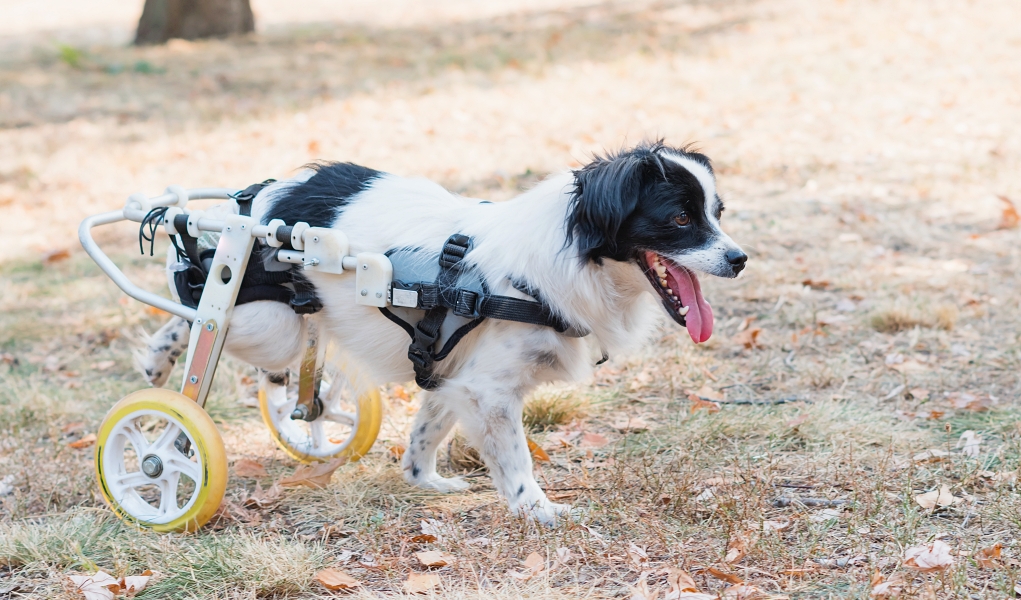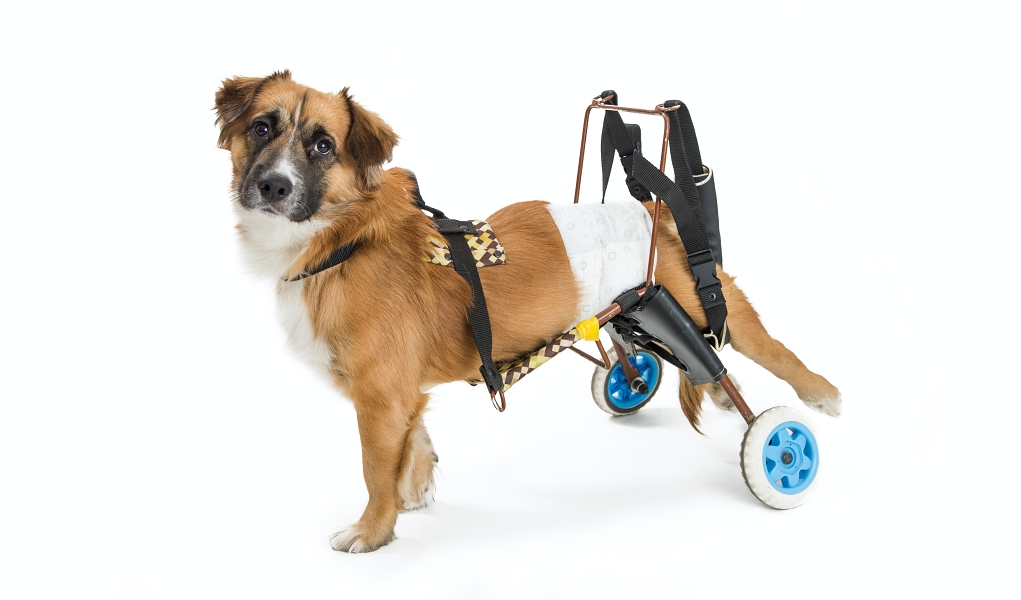Dogs, like humans, can benefit from using a wheelchair when injured or paralyzed. Whether your pup needs a wheelchair for short-term rehabilitation reasons or he will require a wheelchair for the rest of his life, you can learn how to make a dog wheelchair that will meet his needs.
A DIY dog wheelchair will help your pet move around freely and provide him with a sense of normality that life without a chair may not. You can buy commercial dog wheelchairs, but they are expensive. If you're on a tight budget, a homemade wheelchair may be your best option.
A doggy wheelchair will allow your pet to gain most of his mobility back, and it will keep him active and healthy. Depending on your dog's strength and overall health condition, it is likely that he'll still be able to enjoy many of the activities that he did before being confined to the chair. Whether it's short daily walks or a game of fetch, your vet will be able to tell you if your dog is up to the challenge.
How To Make A Dog Wheelchair
A DIY Guide
Before making your dog a wheelchair, you need to have a conversation with your veterinarian. They will help you decide which type of chair will be best for your dog and go over any health and/or safety concerns that you may need to take into consideration.
There are a few essential features that your DIY dog wheelchair needs, and these requirements can change depending on your dog’s condition. For dogs with no ability to use their limbs, they will need to be fully supported and ideally have a wheelchair made-to-measure.
For dogs with partial use of their limbs, they will need a quad-chair that can be adjusted to provide different levels of support. It is important to make sure you get the right wheelchair for your dog's condition. The right chair will allow your pet not only to be comfortable, but also give him full range of motion.
A two-wheeled chair (like the one pictured above) is designed to provide your dog support on either his front or back end. These types of chairs are designed to be weightless on the shoulders, while fully supporting the weight of your pet. We typically think of two-wheeled chairs supporting a pup's hind end, but they can also be designed to support the front end if that is what your pup needs.
Quad chairs offer support to dogs with mobility issues in all four limbs. These can be very useful for rehabilitation after surgery, because you can adjust the level of assistance that the chair provides. Quad chairs allow your dog's legs to touch the ground while providing support, so he can recover gradually.
ALSO: The Vet's Guide On Wheelchairs for Dogs (9 Things to Know)
 How To Measure Your Dog For A Wheelchair
How To Measure Your Dog For A Wheelchair
You must get the right measurements to guarantee a smooth and comfortable ride when learning how to make a dog wheelchair. The thing I like about making your own wheelchair is that you can easily make changes and updates if you notice any areas are chaffing or hurting your pet.
Here are the key areas you need to measure to ensure the perfect fit:
- Back height from hip to floor
- Length from shoulder blades to base of tail
- Inside distance from heels of front feet to toes of back feet
- Chest all the way around just behind the front leg
- Front height, from top of shoulders to floor
- Width of shoulders, straight measurement not curved around
- Width of hips, straight measurement not curved around
- Groin to the floor
How To Make A Dog Wheelchair
Choosing the right kind of canine wheelchair to fit your dog’s needs and lifestyle is essential. The first question to ask is whether your dog needs full support or partial support? This decision will define which kind of chair you'll be making.
The next thing to consider is your dog's size. The bigger the dog, the stronger and larger the wheelchair needs to be. You will also need to consider whether your dog is at his mature height and weight. If he isn’t, you have two choices – either build a new wheelchair in the future or build an adjustable chair now.
Here is a list of tools and items you will need to have on hand when learning how to make a dog wheelchair:
- Saw to cut piping
- Piping (material dependent on dog weight and size)
- Fabric to create a saddle
- Wheels (size appropriate)
- Piping connectors
- Glue (dependent on the piping material)
MORE: Intervertebral Disc Disease in Dogs
It's difficult to give instructions on how to build a dog wheelchair, because you'll need to cater the chair to your dog's exact specifications. Here is a brief guide on the steps that you'll need to follow.
Step 1: Build The Frame
First, you need to construct your frame. You’re most likely going to be using PVC piping for this project, and the easiest way to build your frame will be a mixture of glue and ‘PVC T’s to create the ideal shape.
Remember when constructing your frame that no part of the structure should rub on your dog as that could cause sores or discomfort. I recommend sketching your design first to help you decide the amount of piping and number of connectors that you will need.
Step 2: Wheels
As your frame is constructed from piping, adding wheels is relatively straightforward. Drill some holes in your piping to allow for your wheels to be attached securely with a nut and bolt. Make sure your wheels move freely but provide solid support and do not wobble.
Select wheels that will be best in your dog's typical environment. For example, if you live in the country and your dog spends most of his time outside walking through grass or climbing over different types of terrain, sturdier wheels with better tread will be the best choice.
Step 3: Create The Saddle
Depending on your skill level, you might want to construct a padded saddle frame using piping to provide your dog with the ideal support; while allowing for bathroom activities. This also comes with the benefit of there being less chance of sores and discomfort from a fabric based saddle.
If that’s beyond your skill level – a fabric based saddle is the next best thing – you will want to cut holes in the saddle for your dog's legs and make sure to provide as much support to his pelvic area as possible. You should be able to attach the harness to your frame with some sewing mastery or cable ties.
Dog Wheelchair Examples
I found some great examples of homemade dog wheelchairs with step-by-step instructions. While you'll likely have to make some adjustments to meet your dog's specific needs, these DIY projects may give you some inspiration.
The first is from Rolling Pup's YouTube Channel:
Make-and-Build-Dog-Stuff.com also shares a simple design with step-by-step instructions and pictures of the process. This resource offers options for small, medium and large breeds. They also show instructions for building a few different types of dog wheelchairs, so you may get ideas for the best wheelchair for your pup.
Dogsaholic.com discusses the design process in-depth and shares a shopping list that should help you prepare for this DIY project properly. Not only do they show the step-by-step instructions, but this article also includes an easy-to-follow video guide.
The entire process of deciding on the type of chair your dog needs, measuring him, and ultimately building his wheelchair can be a quick and inexpensive experience. You just have to do a little research and consult your veterinarian to ensure you're providing your pup with a comfortable and safe ride.
READ NEXT: 6 Vet's Tips On How To Care for Senior Dogs














